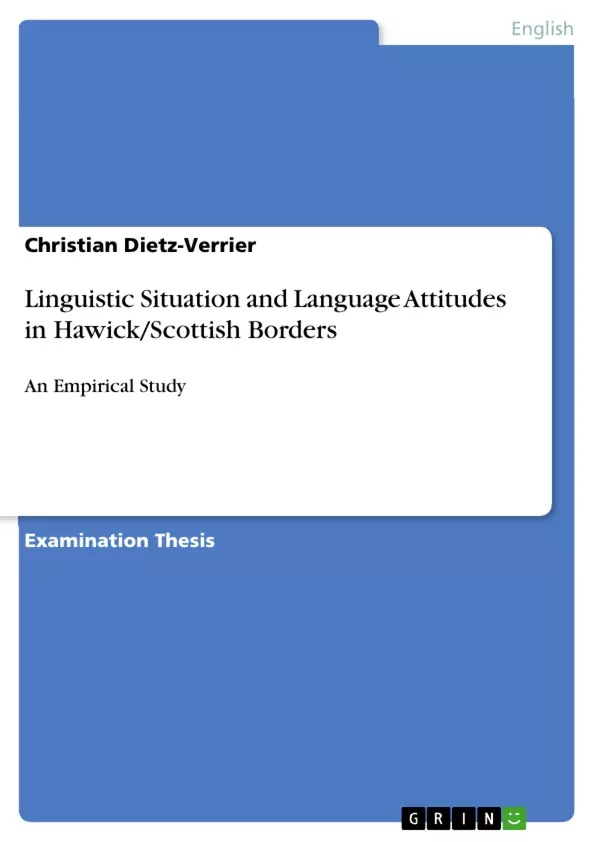The present analysis will focus on two major aspects: the local vernacular as employed in Hawick and its usage in the school context.
The emphasis lies on the present linguistic situation in terms of language usage and attitudes of both pupils and teachers.
The second chapter will supply a brief social, linguistic and historical outline of Hawick and Southern Scots. Subsequently, in the third chapter the methodology and aspects of language attitudes and their measurement will be described.
The fourth chapter, being the main part of the study, is subdivided into two sections. Firstly, the linguistic situation in Hawick in general will be illustrated, and extralinguistic variables are taken into account whenever they prove to be statistically significant.
The final part of the analysis, chapter 4.2, will clarify language use and attitudes towards the vernacular in the school context. The conclusion in chapter five will summarize the most important results and might also serve as an impetus for further dialect and attitude studies.
Inhaltsverzeichnis (Table of Contents)
- Introduction
- Hawick and Southern Scots
- Geography, history and population
- Southern Scots and Braid Haaick
- Methodology and attitudes
- Attitudes and their measurement
- Questionnaire
- Sample
- Analysis
- Linguistic situation and language use in Hawick
- Linguistic situation
- Status of standard speech and local varieties in general
- Regional variation in the Borders
- Attitudes towards BBC London English and local speech
- Status of local speech versus Standard English
- Language change in Hawick and the Borders
- Local identity
- Language use and attitudes at Hawick High School
- Language use in the school context
- Pupils
- Teachers
- Attitudes towards the vernacular at school
- Pupils
- Teachers
- Language use in the school context
- Linguistic situation
Zielsetzung und Themenschwerpunkte (Objectives and Key Themes)
This study explores the linguistic situation in Hawick, a town in the Scottish Borders, and the attitudes towards the local dialect, particularly within the context of Hawick High School. It aims to understand how the vernacular language is used and perceived in the school environment and within the broader community.- The linguistic situation in Hawick, particularly the status and use of the local dialect, Southern Scots, and its relation to Standard English.
- Attitudes towards different varieties of English, including BBC London English and the local vernacular, in the community and the school setting.
- The role of language in shaping local identity and the perceived social value of different speech forms.
- Language use and attitudes among students and teachers at Hawick High School, highlighting potential influences on the transmission and maintenance of the local dialect.
- Potential language change processes occurring in Hawick and the surrounding Borders region, examining the evolution of the local vernacular and its connection to broader social trends.
Zusammenfassung der Kapitel (Chapter Summaries)
- Introduction: This chapter introduces the study's context by describing the author's personal experience in the Scottish Borders, particularly his observations of the local dialect in Hawick. It explains the motivation behind undertaking the study and its focus on the linguistic situation and attitudes towards the local vernacular in Hawick and its school environment.
- Hawick and Southern Scots: This chapter provides a detailed overview of Hawick's geography, history, and population, highlighting the town's unique cultural and linguistic characteristics. It also examines the relationship between Hawick and the Southern Scots dialect, discussing the specific features and characteristics of the local speech variety.
- Methodology and Attitudes: This chapter describes the research methodology employed in the study, including the development and administration of a questionnaire to measure attitudes towards different varieties of English. It outlines the selection of the study sample and discusses the analytical methods used to analyze the collected data.
- Linguistic situation and language use in Hawick: This chapter presents the findings of the study, examining the linguistic situation in Hawick by focusing on the status of both Standard English and the local vernacular. It analyzes the observed regional variation in the Borders and investigates attitudes towards BBC London English and local speech. The chapter further examines the perception of local speech in comparison to Standard English and explores potential language change processes occurring in Hawick and the surrounding region. It also investigates the role of language in shaping local identity.
- Language use and attitudes at Hawick High School: This chapter analyzes language use and attitudes towards the vernacular at Hawick High School. It examines the language use in the school context, focusing on both student and teacher perspectives. The chapter further investigates the attitudes of students and teachers towards the local dialect within the school environment.
Schlüsselwörter (Keywords)
This study investigates the linguistic situation in Hawick, a town in the Scottish Borders, focusing on the local vernacular, Southern Scots, and its relationship to Standard English. The study examines attitudes towards different varieties of English, including BBC London English and the local dialect, both in the community and within the school setting. It explores the role of language in shaping local identity and analyzes language use and attitudes among students and teachers at Hawick High School. This includes examining potential language change processes occurring in the region. Key terms include: linguistic situation, Southern Scots, Standard English, attitudes, language use, local identity, language change, regional variation, Hawick, Scottish Borders, and Hawick High School.- Arbeit zitieren
- Christian Dietz-Verrier (Autor:in), 2003, Linguistic Situation and Language Attitudes in Hawick/Scottish Borders, München, GRIN Verlag, https://www.grin.com/document/284760



